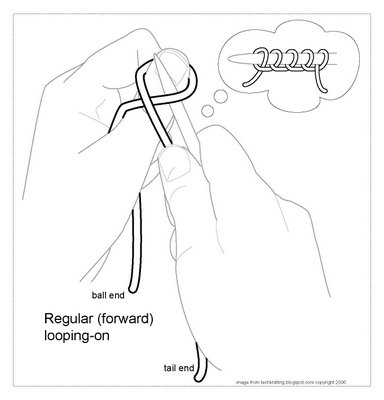click picture
 Gardeners say "a weed is a plant out of place." In your lawn, that purslane is a pest, but in the hands of a Italian chef, it's a tasty side dish. It's the same with looping-on. Looping-on is a horrible way to cast on a heavy sweater and a dismal way to start circular knitting. But in the right place, looping on is a valuable technique--the trick is knowing where to use it.
Gardeners say "a weed is a plant out of place." In your lawn, that purslane is a pest, but in the hands of a Italian chef, it's a tasty side dish. It's the same with looping-on. Looping-on is a horrible way to cast on a heavy sweater and a dismal way to start circular knitting. But in the right place, looping on is a valuable technique--the trick is knowing where to use it.
THE BAD SIDE of LOOPING ON
A looped-on edge is fragile: the loops cross and saw away at one another until they break. Unraveling sleeve ribbing is a common result.
Looped-on loops are skimpy--nothing prevents loops from sharing yarn. As soon as you put your needle into one loop, that loop gets larger, while the loops around it get tighter. The result: lumpy cast-on.
Loooping-on is hard to get "sunny side up" along the needle(s) as you try to connect circular knitting. The loops are so skimpy, its hard to tell which way up they lie. It's easier to make an inadvertent moebius strip with looping-on than with any other method.
THE GOOD SIDE of LOOPING-ON
With all these flaws, when does it ever make sense to use looping-on?
This skimpiest of all casting-on is a perfect match with the skimpiest of all knitted fabric: lace. Some ladies and I at a knitting club meeting were trying to discover how a beautiful piece of Russian lace had been cast on. It took some time and a pair of glasses to find the looped-on edge. A sturdy long tail cast-on would have been easy to see, but the looping-on was nearly undetectable.
Unlike a heavy sweater, lace isn't often subject to stress, so it's irrelevant that the crossed stitches might saw on one another. Also, lace is hardly ever made in the round, so looping-on's distressing tendency to twist--to lay on the needle all twisted-- is also irrelevant.
Of course, even with lace, looped-on loops tend to skitter around the needle when knitting the first row. Also the loops still want to share yarn between themselves, making each stitch a different size than its partners. But by the time you've come to lace, you're better able to control this problem, and in any event, in lace, the result is worth it.
Another reason to use looping on is when you want to cast on new fabric at the end of a row (a dolman sleeve, perhaps) or bridge over previously cast-off stitches (the top of a buttonhole, for example). And now, back to the original text...

